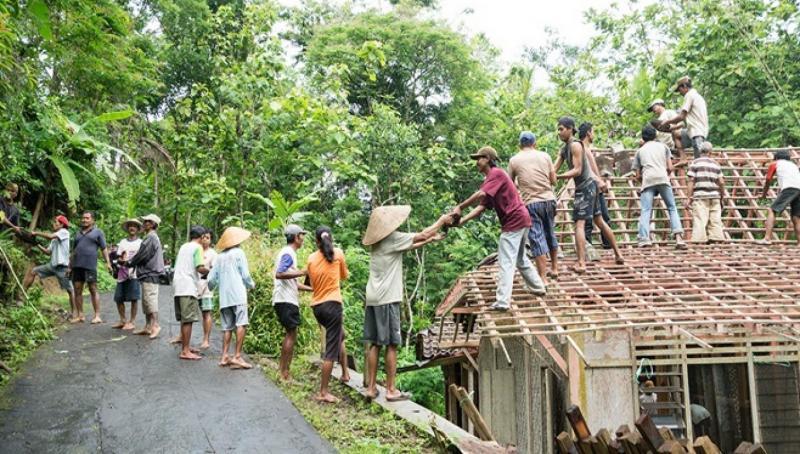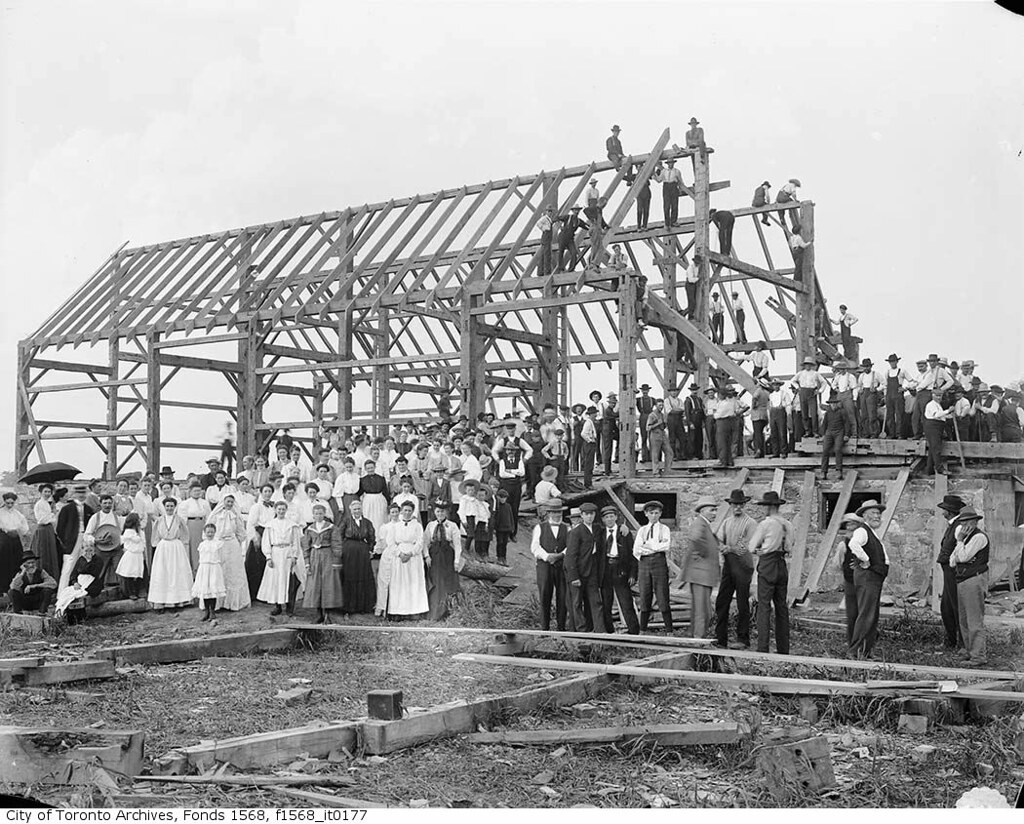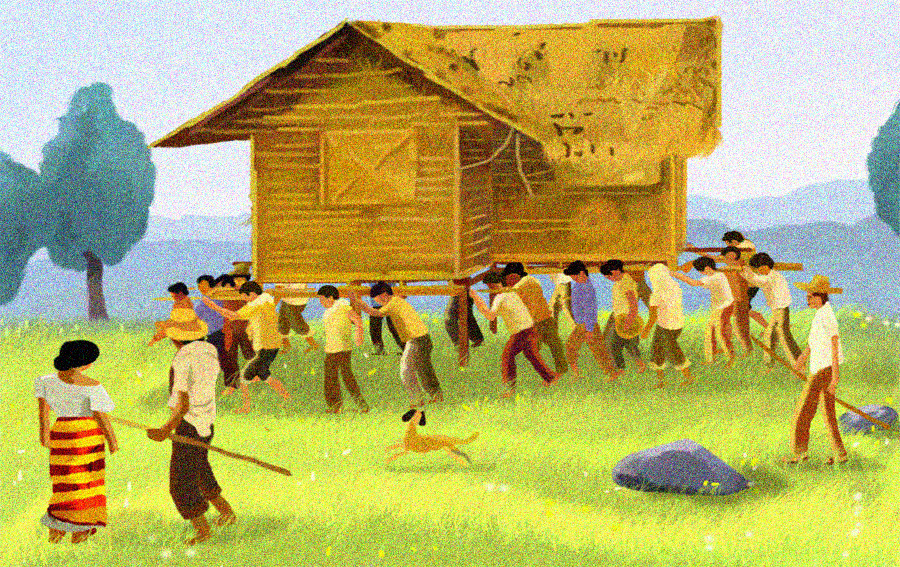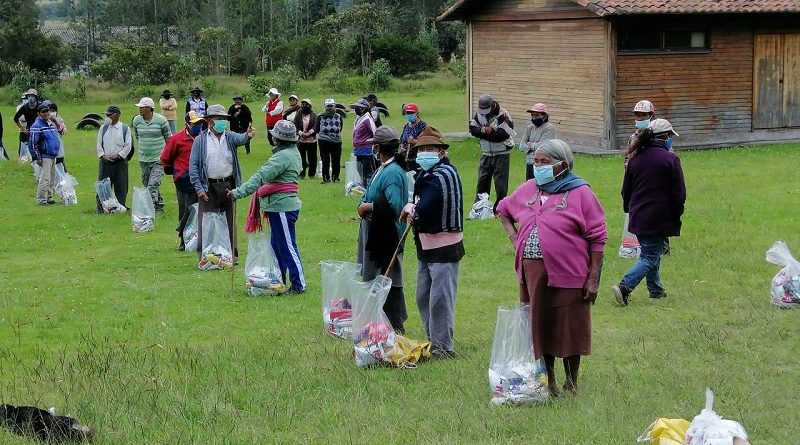
Communal work practices from around the world
cross-posted from Shareable
For all of human history, societies have depended on communal work to sustain themselves into the (often unpredictable) future. However, at a certain point, that all changed. Market forces took over, and communal projects ceased to have the same significance. The individual took precedence over the community, and large public works became the purview of burgeoning states.
The classic North American example of such communal work projects is the Amish tradition of barn-raising, wherein the community gathers to help a neighbor erect their barn without remuneration or any expectation of reciprocity because, as we’ll see, these acts of generosity benefited everyone, not just the barn owner.
Most communal practices have unfortunately faded into obscurity as societies became more atomized, individualistic, and profit-driven. Only a handful of cultures are keeping these traditions alive, albeit in a variety of contexts.

Communal work refers to a collaborative effort where members of a community come together to achieve a common goal or objective. It involves individuals working together in a shared space to accomplish tasks such as building houses or clinics, organizing events, providing services, or undertaking infrastructure projects. Different cultures have different names for it, such as Talkoot (Finland), Gotong-royong (Indonesia), Nachbarschaftshilfe (Germany), and Bayanihan in the Philippines.
How is communal work different from volunteering?
While communal work, volunteering, crowdsourcing, and time-banking all involve collaboration and community involvement, they differ in terms of their scope, focus, and mechanisms of participation. Communal work is specifically centered around community-driven efforts, whereas the others may encompass a broader range of activities and motivations. There are several elements that differentiate communal work from other collective activities:
- Remuneration: Communal work is not remunerated; people willingly offer their time, skills, and resources for the betterment of the community without expecting monetary compensation. The only reward is collective, in the form of food, hospitality, music, or entertainment. This type of prosocial behavior does not mean self-interest must be absent. Much of the work people do together involve benefits for both parties.
- Shared Purpose: Communal work is driven by a common purpose or objective that benefits the community as a whole. This purpose could be improving the community’s infrastructure, enhancing social cohesion, addressing a local issue, or promoting cultural activities. Having a shared purpose helps align the efforts of community members toward a common vision.
- Inclusivity and Diversity: Workers come from within the community, meaning neighbors, friends or family. Communal work is inclusive and embraces the diversity of the community, encouraging the participation and involvement of people from different backgrounds, cultures, and perspectives. Inclusivity fosters a sense of belonging, promotes social equity, and ensures that the benefits of communal work reach all community members.
- Mutual Aid and Support: Communal work emphasizes the principle of mutual aid, where community members support and assist each other in achieving common goals. It involves sharing resources, knowledge, and expertise within the community to uplift its members collectively. Mutual aid creates a sense of solidarity and interdependence among community members.
- Empowerment and Capacity Building: Communal work often focuses on empowering individuals and communities. It provides opportunities for skill development, knowledge sharing, and leadership building. Through communal work, individuals gain confidence, become active contributors, and develop a sense of ownership and responsibility towards their community.
- Collaboration: Communal work involves individuals coming together and working collectively towards a shared goal. It emphasizes cooperation, teamwork, and active participation from all members involved. Collaboration fosters a sense of unity and shared responsibility within the community.
Communal spirit in the Philippines: Bayanihan
For most of us, the only time we witness such selfless acts of giving is during catastrophic events. The utopian structures of support and mutual aid come into existence during humanitarian crises, like Hurricane Katrina or the 1906 San Francisco earthquake. Detailed descriptions of the elaborate support networks that sprang from the rubble during these and other disasters are the subject of the book “A Paradise Built in Hell” by author Rebecca Solnit, which shows how people can be there to support their neighbors and community. However, as Solnit herself asks, “The real question is not why this brief paradise of mutual aid and altruism appears, but rather why it is ordinarily overwhelmed by another world order.” Although this might be true in the U.S., it isn’t always the case globally.

During the eruption of the Taal volcano in the Philippines, the traditional support networks known as Bayanihan came into effect not as a temporary solution to the disaster but as an innate response that Filipinos have in both good times and bad. A response that may have its root in their concept of the “shared self” or Kapwa.
“Unlike the English word ‘Other’, Kapwa is not used in opposition to the self and does not recognize the self as a separate identity. Rather, Kapwa is the unity of self and others and hence implies a shared identity or inner self. From this arises the sense of fellow being that underlies Filipino social interaction.” — Leny Strobel
Communal work in Finland: Talkoot
But it’s not just the Philippines, where community work is part of everyday life. In Finland, Talkoot, which was initially a form of rural cooperation, has seeped into the daily lives of many Finns.
More than half the population of Finland now lives in cities, yet informal volunteering and support are still important factors in everyday life. According to Hannu Pääkkönen, “People spend almost one hour a day in social-capital activities such as socializing, neighborly help, and volunteering; and almost one-third of the population engage in volunteering each month. Each month 60 percent of the population offer neighborly help.”
There is a Finnish maxim that says, “one must never buy what one can make.” Fittingly, a disproportionate number of pioneers in the open-source software realm have been Finnish. Most famously, the Linux operating system was initiated by Linus Torvalds in 1991, and maybe less so famous, the Swedish-Finnish-grown MySQL server architecture in 1994. Furthermore, Internet Relay Chat (IRC) was initiated by Jakko Oikarinen in 1988. In each of these cases, the work (of programming) was never done alone, and calls for support were made to develop them. One can draw the conclusion that Talkoot culture could have driven these enterprises. Tuija Aalto of the Finnish national broadcasting corporation has said, “Finns always know how to get a big project done. Be it building a new sauna or an operating system: invite the whole community to do the job.”
In explaining the historical roots of Talkoot, docent, and scholar Tapani Köppä references the combination of long Finnish winters and short summers, which have encouraged rural communities to cooperate more willingly. Similar conditions prevail in other northern climates, and similar translations of the Finnish Talkoot can be found throughout the surrounding areas. For example, Latvians and Lithuanians use the word Talka, while in Estonian, it is described as Talgud. The Belarusian word, Тaлока (Taloka), is said by some to be a linguistic borrowing of one of the Baltic languages. Furthermore, there is a very similar word in Ukrainian, Толока (Toloka), and in Polish, it is known as Tłoka.
Traditional communal work in Latin America: Minga
In Andean countries, the tradition of communal work can be traced back to the pre-Columbian Maya and Inca civilizations, where it was known as Kuchuj and Minka, respectively. Over time Minka became Minga, the philosophy of which is not unlike the others mentioned so far.
The spirit of the traditional Minga is living together, sharing, learning, living in community, maintaining unity, and, above all, strengthening the ties between ayllus (families). One notable project keeping this spirit alive is the Alianza Solidaria housing co-op in South Quito, Ecuador.
In 2000, the cooperative purchased a plot of land of roughly six hectares (~15 acres) in the south of the city, where they built the ‘Solidaridad Quitumbe’ social housing project “dedicated to the construction of habitat, housing, and community through cooperation, self-management, and solidarity economy, and ways for good living”.
Alianza Solidaria asks its members to contribute 100 hours of community work, which is used to clean the ravines around the housing estate, and which are then given back as publicly accessible parks to all citizens, hence functioning as a commons.

But Minga goes much further. Throughout Latin America, there are many Minga-inspired organizations that take on public works projects which the state cannot afford to undertake in far-flung rural settings. One such type of project is providing running water. It is estimated that more than 77,000 such community organizations provide water to around 40 million people in rural Latin America — an unimaginable feat!
Why we need more communal work
Recently, the U.S. Surgeon General, Vivek Murthy, wrote an opinion piece for the New York Times about the “loneliness epidemic” in the U.S. In it, he writes that “At any moment, about one out of every two Americans is experiencing measurable levels of loneliness. This includes introverts and extroverts, rich and poor, and younger and older Americans.”
He starts the essay with an anecdote about a patient he once had who, after winning the lottery, found his life to be more lonely and isolated after moving from his close-knit neighborhood to a gated community. This paradox is visually palpable in a German documentary by Harun Farocki that is a personal favorite of mine called “By Comparison.” The film has no dialogue but simply shows people around the world working in groups to produce bricks.
Farocki chose to study this fundamental object due to its ubiquity in almost all societies throughout history. Some of the oldest architectural elements that are still in existence are made from bricks. Bricks are also a metaphor for humans: all different, but all doing their individual parts to hold society up, without which it would crumble.
The film begins in Burkina Faso, where an entire village is building a clinic for themselves. It’s a chaotic system but efficient, and everyone seems to be enjoying themselves.
The film then travels to India, where groups of women are making clay bricks by hand, then to the Middle East, where people are making mud bricks, and so on. All the groups of people are being social, some are paid, and some, like the folks in Burkina Faso, are volunteering for their own well-being.
Finally, we arrive at a brick factory in Switzerland. There is a solitary man, not looking particularly happy, who pushes buttons on a machine, and robots take the bricks out of an oven and stack them up; no human hands touch the product during the process. This operator’s job looks quite boring, while the others working together seem to be enjoying themselves a bit more, as much as you can while making bricks I suppose, but with the singing and dancing at the end of the day that you just don’t get with robots.
Not only is it sociality beneficial, but also the act of completing the task with others is infinitely rewarding. In the book “Shop Class as Soulcraft,” Matthew Crawford writes:
“The satisfactions of manifesting oneself concretely in the world through manual competence have been known to make a man quiet and easy. They seem to relieve him of the felt need to offer chattering interpretations of himself to vindicate his worth. He can simply point: the building stands, the car now runs, the lights are on.”
Not only do these activities make your life more enjoyable, but they also make it longer, too. The Greek island of Ikaria is known as a place where people “forget to die.” In fact, a great number of people there live past 100, and scientists have been trying to figure out why. A combination of factors like exercise, diet, and socializing seems to be the answer.
Unfortunately, for the most part, the only barn-raising to be found nowadays is tiny houses. While several websites have been launched to help people connect with their neighbors, such as Lotsa and Nextdoor, the reality is that people don’t really have time to participate in their own communities anymore. If you consider that a medieval peasant in Europe had at least 60 feast days per year, the 40-hour work week and limited PTO, though lucrative, could be costing us our health.
There are also geographic factors that inhibit community as well. The Swiss writer Hans Widmer, aka P.M., has called for an entire redesign of how neighborhoods are built to allow for more communal space where neighbors can physically connect with each and share activities. In Mexico, a legal instrument was created called Ejido whereby land can be both social and private property, which contains a mix of individually parceled land and some land that is held and used communally. A former Googler has initiated a similar concept in India where groups of people are seeking to escape the cities in favor of a more sustainable lifestyle by buying massive swaths of land that are held both privately (for your house) and collectively (for the communal farmland).
There are many barriers to forming a community in modern societies; however, it doesn’t have to be that way. There are still activities you can initiate to reinforce community bonds that don’t involve dam building. For example, I go foraging with my neighbors to gather edible plants in our area. Then we process them and pickle them so we all have these delicacies to eat throughout the year. If you think you can’t forage in your area, check out Alexis Nikole, a foraging teacher who could find food on the moon.
Header image: Generating gotong-royong (mutual cooperation to realize shared goals) in Sawahan, Indonesia. Photo source: berita. suaramerdeka.com

Add new comment